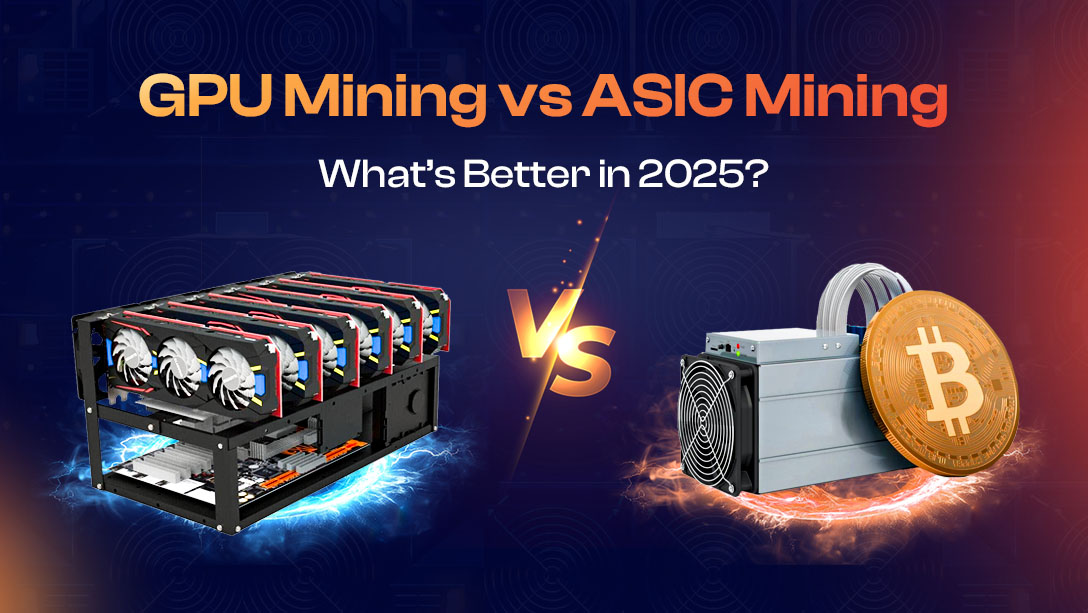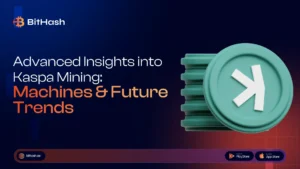The cryptocurrency mining landscape continues to evolve at a rapid pace, and miners must constantly adapt their strategies to maintain profitability in this competitive sector. In 2025, the debate between GPU mining and ASIC mining remains more crucial than ever, as each approach offers distinct advantages depending on critical factors like electricity costs, coin selection, mining difficulty, and current market conditions.
For those engaged in bitcoin mining, the efficiency of ASIC miners has become increasingly important as network difficulty reaches new heights. Meanwhile, GPU-based mining rigs continue to offer versatility for altcoin miners who participate in smaller mining pools or target emerging cryptocurrencies. The choice of mining hardware directly impacts your mining profitability, with energy consumption being one of the most significant operational costs to consider.
This in-depth guide provides a comprehensive comparison of GPU and ASIC mining in 2025, examining all key aspects from initial investment to long-term ROI. Whether you’re a hobbyist building a home setup or a professional miner optimizing a large-scale operation, our analysis will help you determine which approach best aligns with your crypto mining goals and resources.
Graphics Processing Unit (GPUs) Mining
GPU mining utilizes graphics processing units (GPUs) to mine cryptocurrencies, offering a flexible alternative to specialized ASIC miners like Bitcoin miners. Unlike single-purpose ASICs, GPUs can switch between different mining algorithms, allowing miners to target the most profitable coins—from Ethereum Classic to newer, GPU-friendly tokens.
Why Choose GPU Mining?
- Multi-Algorithm Support – Mine various coins without changing hardware.
- Lower Entry Cost – A basic mining rig with 6-8 GPUs is more affordable than high-end ASICs.
- Better Resale Value – GPUs retain value for gaming, AI, or rendering if mining becomes unprofitable.
- Adaptability – When mining rewards shift, GPU miners can quickly switch coins.
Challenges of GPU Mining
- Lower Energy Efficiency – GPUs consume more power per hash than ASICs, increasing energy costs.
- Cooling Requirements – Effective cooling systems (fans or liquid cooling) are essential to maintain performance.
- Competition from ASICs – Major coins like Bitcoin are now dominated by ASICs, pushing GPUs to altcoins.
Optimizing GPU Mining in 2025
- Use Renewable Energy – Solar or wind power can offset high electricity expenses.
- Monitor Mining Rewards – Track profitability daily using tools like WhatToMine.
- Balance Hardware Costs – Weigh GPU prices against expected returns.
While CPU mining is nearly obsolete for most coins, GPU mining remains viable for altcoins—especially in regions with cheap power. For miners prioritizing flexibility over raw hash power, GPUs are still a smart choice.
Popular GPU-Mineable Coins in 2025
- Ethereum Classic (ETC)
- Ravencoin (RVN)
- Ergo (ERG)
- Kaspa (KAS) – (Some GPUs still competitive)
- Flux (FLUX)
- Newer GPU-friendly coins (AI training tokens, DePIN projects)
Pros of GPU Mining
Flexibility – Switch between different coins based on profitability.
Lower upfront cost – No need for expensive ASIC hardware.
Resale value – GPUs can be repurposed for gaming, AI, or rendering.
Decentralization-friendly – Supports smaller networks and new projects.
Adaptability – Can mine emerging coins that ASICs don’t yet dominate.
Cons of GPU Mining
Lower efficiency – Higher power consumption per hash compared to ASICs.
Less profitable for Bitcoin – Most major PoW coins are now ASIC-dominated.
More maintenance – Requires tuning, cooling, and frequent profitability checks.
Application-Specific Integrated Circuit (ASIC) Mining
ASIC (Application-Specific Integrated Circuit) miners represent the pinnacle of cryptocurrency mining technology. These specialized mining machines are engineered specifically to mine particular algorithms with maximum efficiency, whether it’s SHA-256 for Bitcoin, Blake2S for Kadena (KDA), or other proof-of-work algorithms. Unlike general-purpose computing hardware, ASICs are designed from the ground up to perform these specific cryptographic calculations, resulting in unparalleled performance that dominates the mining industry.
Key Advantages of ASIC Mining
Here are some key advantages of ASIC Mining:
- Unmatched Hashing Power:
ASIC miners deliver hash rates that dwarf what’s possible with GPUs or CPUs, often by orders of magnitude. For example, the latest Bitcoin ASICs achieve hundreds of terahashes per second. - Superior Energy Efficiency:
With power efficiency ratings as low as 16-20 joules per terahash, modern ASICs minimize electricity costs – a crucial factor given today’s energy prices. - Simplified Operation:
The plug-and-play nature of ASIC miners means you can be up and running with minimal configuration – just connect to power, networking, and your preferred mining software.
Challenges to Consider
Major Challenges to consider are
- Algorithm Lock-In:
Each ASIC model can only mine one specific algorithm. A Bitcoin miner can’t switch to mine Kadena, and vice versa. - Significant Capital Investment:
Top-tier models like Bitmain’s Antminer S21 or MicroBT’s Whatsminer M60 represent substantial upfront costs, often running thousands of dollars per unit. - Thermal Management Requirements:
The incredible computational power comes with substantial heat output, requiring robust cooling solutions ranging from high-velocity fans to advanced immersion cooling systems.
Optimization Strategies for 2025 Operations
Some optimization strategies for 2025 are:
- Energy Source Selection:
- Leverage renewable energy resources like solar or wind, where possible
- Seek locations with favourable electricity pricing
- Consider waste heat utilization systems
- Operational Approaches:
- Joining established mining pools rather than solo mining
- Exploring cloud mining options for those without infrastructure
- Implementing advanced cooling solutions to extend hardware lifespan
- Maintenance Best Practices:
- Regular cleaning and dust management
- Firmware updates and performance tuning
- Environmental controls for optimal operating conditions
The ASIC mining landscape continues to evolve rapidly, with manufacturers pushing the boundaries of what’s possible in terms of both raw hashing power and energy efficiency. While the barriers to entry have risen significantly, ASIC mining remains the most profitable approach for serious mining operations with access to the necessary resources and infrastructure.
For those able to make the substantial upfront investment and manage the operational requirements, ASIC miners offer the clearest path to profitability in today’s competitive cryptocurrency mining environment. The key to success lies in careful planning around energy costs, cooling solutions, and ongoing maintenance to maximize the return on your hardware investment.
Top ASIC Models in 2025
- Bitmain Antminer S21 (200 TH/s, 17.5 J/TH) – Best efficiency for Bitcoin.
- MicroBT Whatsminer M60 (270 TH/s, 22 J/TH) – High hash rate, competitive pricing.
- Bitmain Antminer KS5 (for Kadena) – Leading KDA miner.
- iBeLink BM-K1 (for Kaspa) – Dominates KAS mining.
Pros of ASIC Mining
Extreme efficiency – Far lower power consumption per hash than GPUs.
Higher profitability (for supported coins) – Dominates Bitcoin, Kadena, Kaspa.
Easier setup – Plug-and-play compared to GPU rigs.
Long-term stability – Less affected by mining algorithm changes.
Cons of ASIC Mining
No flexibility – Can only mine one algorithm (e.g., SHA-256 ASICs can’t mine Kadena).
High upfront cost – Latest ASICs cost thousands of dollars.
Loud & hot – Requires proper cooling and noise management.
Obsolete faster – Newer ASIC models quickly outperform older ones.
GPU vs ASIC Mining: Key Comparisons (2025)
| Factor | GPU Mining | ASIC Mining |
| Profitability | Moderate (depends on altcoins) | High (for Bitcoin/KDA/KAS) |
| Upfront Cost | Lower ($500–$3,000 per rig) | High ($2,000–$6,000 per unit) |
| Power Efficiency | Lower (less efficient) | Best (optimized for mining) |
| Flexibility | High (can mine many coins) | None (locked to one algorithm) |
| Lifespan | 3–5 years (usable for other tasks) | 2–4 years (may become obsolete) |
| Best For | Altcoin miners, small-scale ops | Large farms, Bitcoin/KDA miners |
Which is Better in 2025?
The choice between GPU and ASIC mining ultimately depends on your specific goals, budget, and mining setup.
Choose GPU Mining If
GPU mining is the preferred choice for miners who value flexibility and adaptability. Unlike ASICs, GPUs can switch between different mining algorithms, allowing you to mine various cryptocurrencies and pivot to the most profitable options as market conditions change. This versatility makes them ideal for exploring new blockchain projects and supporting decentralized networks.
- Multi-Coin Support: Mine Ethereum Classic, Ravencoin, and other GPU-friendly coins with the same hardware
- Lower Barrier to Entry: Build a mining rig gradually by adding GPUs as your budget allows
Another key advantage is the better resale value and secondary use cases for GPUs. If mining becomes unprofitable, your graphics cards can be repurposed for gaming, AI workloads, or video editing. This makes GPU mining a less risky investment compared to specialized ASIC hardware.
- Hardware Flexibility: Use your GPUs for other computing tasks if mining slows down
- Home Mining Friendly: More suitable for residential environments due to lower noise and heat output
Choose ASIC Mining If
ASIC mining is the ultimate solution for serious miners focused on major cryptocurrencies like Bitcoin, Kadena, and Kaspa. These specialized machines deliver unparalleled efficiency and hash power that GPUs simply can’t match, making them essential for profitable large-scale operations.
- Unmatched Performance: Achieve hash rates hundreds of times faster than GPU setups
- Enterprise-Grade Efficiency: Maximize profits with industry-leading joules-per-terahash ratings
The tradeoff for this performance is higher upfront costs and complete lack of flexibility. ASICs are single-purpose machines that can only mine their specific algorithm, so you’ll need different models for different cryptocurrencies. They also require proper infrastructure to handle their substantial power and cooling needs.
- Industrial Scale Required: Best suited for dedicated mining facilities with proper ventilation
- Long-Term Profitability: Higher initial investment pays off through sustained efficiency advantages
For miners with access to cheap electricity and proper facilities, ASICs offer the most direct path to mining profitability at scale. Their plug-and-play operation and minimal maintenance needs make them ideal for professional mining operations.
Future Outlook: Will GPU Mining Survive?
While ASIC miners have established dominance in Bitcoin and major proof-of-work cryptocurrencies, GPU mining continues to maintain a significant niche in the crypto ecosystem. The future viability of GPU mining depends on several evolving factors that could either extend its relevance or accelerate its decline.
Key Factors Influencing GPU Mining’s Future:
Here are some factors that influencing GPU Mining’s Future:
- Altcoin Ecosystem Development:
- Continued emergence of new GPU-friendly coins
- Growth of decentralized infrastructure networks (DePIN)
- Development of AI-training tokens and other novel blockchain applications
- Hardware Advancements:
- Next-generation GPUs like Nvidia’s Blackwell architecture
- Improved energy efficiency in consumer graphics cards
- Specialized mining-oriented GPU designs
- Market Dynamics:
- Fluctuations in cryptocurrency values
- Changes in mining difficulty across different networks
- Regulatory developments affecting proof-of-work systems
Challenges Facing GPU Mining
Following are some major challenges facing GPU mining:
- Increasing Competition from ASICs:
As ASIC manufacturers continue to improve efficiency, the performance gap keeps widening, and more algorithms are being targeted by specialized hardware. - Energy Efficiency Concerns:
Rising electricity costs globally, Environmental pressures on proof-of-work systems, and Regulatory scrutiny on energy-intensive mining - Economic Viability:
Fluctuating cryptocurrency values, declining block rewards over time, and Increased network difficulty across all chains.
Market Projections for 2025 and Beyond
The GPU mining sector will likely see continued contraction in traditional cryptocurrency mining but may find new life in emerging sectors. While it’s unlikely to regain dominance in Bitcoin or major established coins, the flexibility of GPU systems ensures they will remain relevant for:
- Early-stage cryptocurrency projects
- Niche algorithms resistant to ASIC development
- Experimental blockchain applications
- Hybrid computation platforms that blend mining with other workloads
Final Verdict
- For Bitcoin/KDA/KAS mining → ASICs win (highest profits).
- For altcoin flexibility → GPUs still have value.
Conclusion:
In 2025, ASIC miners like Bitmain’s Antminer S21 and MicroBT’s Whatsminer M60 remain the best choice for profitable Bitcoin mining due to their superior efficiency.
Meanwhile, GPUs like Nvidia’s RTX 4090 are ideal for flexible altcoin mining and newer projects. Choose ASICs for maximum profits on major coins or GPUs for versatility with emerging cryptocurrencies. Your mining goals and budget will determine the best option.





